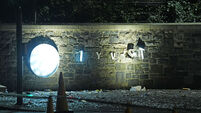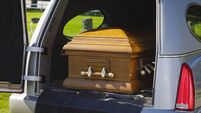Irish Examiner view: Double threat as Donald Trump's tariffs could spark US-EU trade war

US president Donald Trump meeting his cabinet at the White House last week ahead of the wide range of tariffs he announced on Wednesday. Picture:AP/Pool
Now that the dust has settled on US president Donald Trump’s tariff announcement, we are left to sift through the bluster for the fine print.
And there is quite an amount of sifting to do. Mr Trump has been ridiculed for imposing tariffs on some of the remotest and emptiest territories on earth, from the territory of Heard Island and McDonald Islands to Svalbard and Jan Mayen.
However, the implications for Ireland are no laughing matter. Members of the EU have been hit with a 20% tariff, while some other countries have been saddled with even higher tariffs.
The full ramifications of these decisions will need to be teased out in the coming days and weeks, but the description of Mr Trump’s actions as the most significant change in global trading arrangements in almost a century is no understatement. Hence the chorus of voices heralding a long period of uncertainty and warning of damage to economies around the world.
EU officials have said they will take time to analyse the impact of Wednesday’s tariffs before deciding on a likely response, but one senior official said the EU would “hit the US where it hurts”, which brings us to Ireland’s situation.
One immediate effect of the tariffs will be to raise the price of Irish goods on American supermarket shelves, such as butter and whiskey. This is hardly welcome news for producers in the food and drinks sector, but it is not the only storm cloud on the horizon.
Many observers have pointed out that the large Irish pharma sector appears to have avoided Mr Trump’s gaze and has been spared specific, punitive tariffs — for now. It is a subject the US president and his advisers are likely to revisit in the future.
Our situation is a delicate one insofar as EU retaliation may inflict collateral damage on us, while American tariffs have the potential to hit Ireland hard at the same time. Fending off this double threat will provide the Government with a stern test.
Belfast’s Court of Appeal is currently hearing an application by landowners which challenges the commencement of works to upgrade the A5 road in Tyrone. The £2bn (€2.37bn) works are aimed at improving what has been described as one of the most dangerous in the country.
Families who have lost loved ones in accidents on the road got the chance to address the court this week. They were backed by GAA president Jarlath Burns, who said it was important that the association stood with those people. “Getting the A5 properly upgraded is a human rights issue. It is a GAA road, if you want to call it that, because Tyrone’s main GAA centre is on it. There have been so many lives lost,” he said.
The road is undoubtedly a dangerous one in its current iteration — upgrading plans were first announced 18 years ago and, since then, 57 people have been killed in various accidents along the road. These works are clearly needed.
However, Mr Burns’ advocacy of this matter raises some questions. Nobody doubts the intentions of those pushing for the road to be improved in order to save lives, but calling for those works to be carried out on the basis that this is a “GAA road” is an odd premise.
It begs the obvious question of defining what a GAA road is, as opposed to being another sport’s road, for one thing.
For another, does the GAA’s advocacy in this case mean it would not support improving an equally dangerous road — but one which served other sports and games?
There is also the significant matter of the Government promising £500m (€596m) towards the cost of the project.
Questions must be asked about Irish taxpayers’ money being allocated to an infrastructural project in another jurisdiction, coming at a time when so much of the road network in Ireland is in sore need of upgrading.
The GAA’s traditional reticence on political involvement seems to have been sidestepped here: Can we expect the association to agitate for infrastructural improvement across Ireland now? Plenty of roads in Ireland unaffiliated with any sport, pastime, or hobby could do with just this kind of help.
The death of Gaelic football legend Mick O’Dwyer at the age of 88 was announced yesterday.
It is a cliche to say a sportsman enjoyed a storied career, but no other description will do for O’Dwyer, a native of Waterville in south Kerry. Any of his various incarnations would itself serve as a complete narrative: In youth a dashing wing-back with Kerry, he reinvented himself at the end of his playing career as a prolific scoring forward.
Retiring from the playing arena, he became Kerry senior manager and won eight All-Ireland senior titles in 12 years. Later he drove the Kildare footballers to a first All-Ireland appearance in over six decades, Laois to a first Leinster title in over five decades, and Wicklow to the Tommy Murphy Cup, their second ever national title.
For many readers, he will forever be the energetic sideline general urging on his Kerry side, hair jet black and V-neck jumper bright green, in the old Croke Park with its lowering stands and dark crowds: His natural environment. Decades ago, he became known all over Ireland by his first name, but in his own place he was referred to by his surname: Dwyer.
Ar dheis Dé go raibh a anam.













